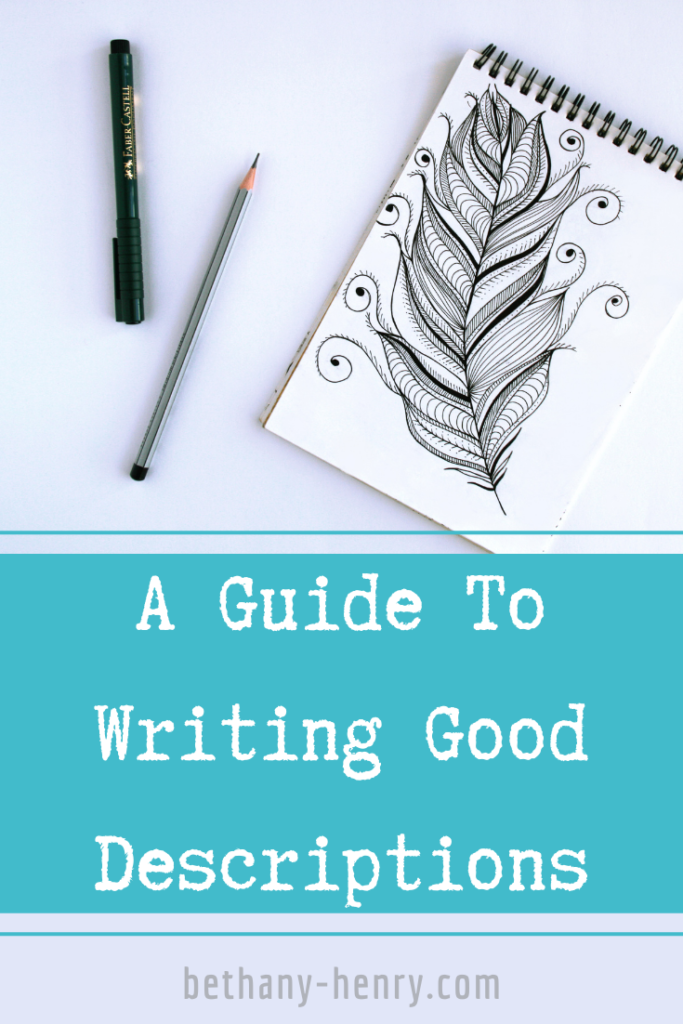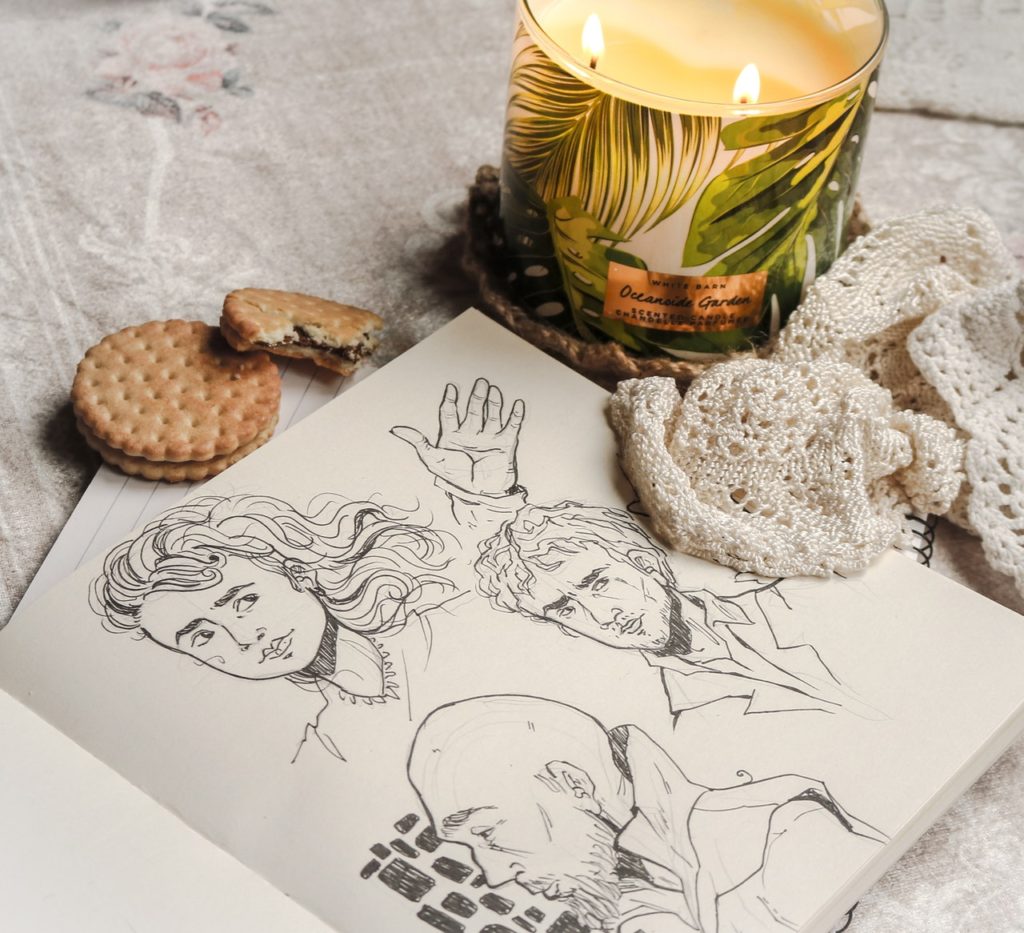
Descriptions are a vital piece of writing. We are storytellers, after all, and that means we need to show our readers what’s going on, pull them into the world we’ve created, and evoke emotions and connection. Description is a large part of how we do that.
Despite being vital, it’s not actually something all writers (including myself!) are naturally very good at.
Like many things, improving our description-writing game can take some work.
Which is why we’re here today, so hold on tight because we’re going to cover a lot of ground! This guide will go over why description writing can be hard, 10 techniques for writing good descriptions, 3 pitfalls to avoid, how to describe characters, and a few practice prompts.
Writing Good Descriptions: Why It’s Hard
If writing descriptions is easy for you, pay no mind. (In fact, please let me know your secrets!)
But for the rest of us, you’re not alone. Sometimes writing descriptions- even really simple ones- can feel extremely difficult.
Everyone’s situation and writing style is going to be different but a few common struggles when writing descriptions may be due to:
- We don’t actually know what things look like ourselves
- We know the details but just forget to include them
- It’s just not how our brain works
- We’re more focused on other aspects of the story
Any of these sound familiar?
There’s no right or wrong way to approach anything in writing, including this! However, hopefully understanding our own writing style and what we struggle with will help us practice and move forward.

Writing Good Descriptions: 10 Techniques
There are doubtless many more rules and tips that could be shared here but for today we have 10 techniques to help us write better descriptions! Feel free to share any I missed below in the comments 🙂
1. Be Specific
Is our character having a drink or is it an ice cold glass of pink lemonade? Is their car a shiny silver BMW or a beat up white Geo Metro with a 3-cylinder engine?
Details matter. Adding 1-2 specific descriptions to a scene can help the reader envision what is going on and make it come alive.
2. Go Deeper
It is important to include details but these details shouldn’t always be surface-level observations. Our first descriptions are almost always simple and/or based on cliches, resulting in a scene that looks like any other scene or a story that sounds like any other story. In order to not bore our reader, we need to go deeper.
For instance: A winter day in New England is cold- including that in our story that doesn’t really tell us much. Is it a brisk cold with the air sharp in your lungs when you breathe? Is it blindingly bright with the sun reflecting off piles of snow? Is there slush accumulating on the sidewalk or can you smell the wood smoke of fires being lit indoors? Can you hear the sound of a plow scraping by?
Helpful hint: It can be useful to jot down a list of possible words or sights, sounds, smells, and images that could be used in a scene or situation. Write the first few that come to your head and then write at least five more. Often it’s those less obvious images further on that can prove to be more specific or interesting.
3. Be In Character
Our stories are told from a certain point of view, often from one or more of our primary characters. This influence our description writing because this character or characters are essentially who we see the world through.
For instance: If our main character is a farmer, they may walk past a field and feel at home, be able to identify what crop is growing and how healthy the plants are, and observe what the general state of the farm. They may use specific farming terms and vocabulary.
If our character is not a farmer then they may walk past the same field and instead feel curiosity about the strange plants or feel uncomfortable being away from the city.
Our character’s point of view should influence our descriptions.
Obviously some descriptions may be fairly universal, however reviewing them to make sure we keep a consistent point of view is important.
For further reading on POV check out Bethany’s Best: Writing Point of View & More.
4. Be Yourself
Along with our point-of-view influencing the descriptions in our writing, we are also influenced by the tone and style of the story as a whole.
Our writing styles won’t match someone else’s exactly and that’s a good thing.
A writer such as Stephen King will have a different description writing style than Terry Pratchett.
We want to take the time to identify our personal writing style and the tone of each story we write so that we can fit the description to match.
5. Not Too Much
Too much description is boring.
There, I said it. I’ve been guilty of skimming paragraphs of description that I didn’t feel was needed in books in order to get to the “good parts” (aka: the action)… anyone else?
If everything single little thing is described in great detail then we run the risk of confusing, overwhelming, and losing our readers.
We want to prioritize and have our descriptions focus on the important bits and let our readers’ imaginations fill in the rest.
Obviously everyone has a different sweet spot of how much is too much. This will depend on your personal writing style and the story itself.
6. Not Too Little
While we don’t want too much description, it is just as important not to have too little.
Our story shouldn’t take place in a blank void because we have failed to provide a backdrop. It is vital we provide sufficient description to ground our readers in the story.
Essentially we want to make sure we consistently set the stage, introduce characters, and then add periodic reminders of our surroundings.
At the start of each scene we want to make sure the setting and characters are established and then every so often we want to slip in reminders to reground us in the scene. These reminders may be a reference to the setting, a sound in the background, a comment on the time, or any simple mention of who is where or what they are doing.
It doesn’t need to be complicated, just a little sprinkle of information to remind us where we are.
7. Match The Pace
How much description we want can depend on the pace of the story.
If we are starting our story off nice and slow we may have time for a leisurely description of the gardens and the climate, however if we are in the middle of a chase scene then we only have time to identify possible escape routes and further description would just slow us down.
We want to pay attention to the pacing of the story and adjust our descriptions accordingly.
8. Be Active
Sometimes descriptions may be methodical or basic and that’s okay, however, when our descriptions can be active it can add energy and life to our writing. Even inanimate objects can be described with active language, such as a bookcase looming or a TV facing the room.
9. Avoid Numbers
Sometimes using numbers is just fine when describing a scene. However, most of us don’t actually count all the things around us all the time in real life.
While it may be more technically specific to use numbers when describing things (ie: the apartment was 400 square feet), it may be difficult for readers to imagine what that actually looks like. Instead we could say her bed barely squeezed into the apartment, her books were piled in the bathroom, and the rest of her furniture was forced to live in her friend’s basement.
While this second description don’t have any numbers, it’s easy to imagine a tiny apartment and cramped living space.
While sometimes it’s good to be specific (see technique #1!), sometimes using a more general term (like a handful or a hoard) can help paint a better picture.
10. Have Fun!
With all of our descriptions (and with all of our writing!) it is important to remember to have fun. We’re the creators here! When we write descriptions we get to play god a bit, we get to make something new, and we can ideally make something we like.
Play with the words and fill the story with shiny and wonderful things!

Writing Good Descriptions: 3 Pitfalls To Avoid
1. Stereotypes
It can be easy to include stereotypes in our writing without meaning to. Common areas that stereotypes creep in are in relation to gender, sex, class, race, mental health, physical health and ability, and religion.
Stereotypes can often be hurtful and damaging and they overlook the complexities of real life. In our writing we should strive to be inclusive as well as accurate in our portrayal of people and places.
Research and getting feedback from beta readers are two essential ways to ensure we aren’t letting stereotypes find a place in our work.
2. Cliches
This is related to stereotypes in that it is easy to include cliches without thinking twice. In our writing this can look like anything that feels overdone or contrived such as having a character describe themselves by looking at themselves in a mirror.
When we find ourselves using the same setting, character, or story line everyone else is using it can be tired and boring.
Obviously there will be some overlap and similarities (check out my story structure 101 series for some common framework that can be helpful!) but we want to ensure our story is unique enough to set it apart from the rest.
3. Summarizing
Sometimes summarizing can be a helpful way to tell pieces of our story.
But sometimes we get carried away with flowery language and it can be tempting to just continue to tell our story instead of showing it.
If we find ourselves summarizing lengthy passages or just telling what happened at dramatic moments instead of letting the reader see it, we need to step back, regroup, and force ourselves to evaluate whether or not there is a way to describe the scene and bring it to life.

Writing Good Descriptions: Characters
Being able to describe characters is an important way to help our readers get to know them!
Here are a few aspects of character descriptions we can utilize:
- Clothing/Items
- Attitude/Body Language
- Body Type
- Skin Tone
- Eyes
- Hair
Inclusion and representation of diverse characters is incredibly important and we should always be considering how we can reflect that in our storytelling. However, we also need to be aware of stereotypes and how to describe people in accurate and respectful ways. For instance, using food words to describe characters of color is often considered offensive.
Do research, especially by the individuals you are wanting to portray, and get feedback.
Check out these great resources to get your research started:
Writing With Color – A site “dedicated to writing and resources centered on racial, ethnic and religious diversity.”
Experiences of Disability – A resources at Writing Alchemy where people can share their own stories and experiences for others to learn from.
Mythcreants – A site with a variety of well researched posts on these topics, including advice on how to describe various types of characters in respectful ways.
For even further reading check out my posts How To Include Mental Health Issues In Our Fiction and A Guide For Writing Strong Female Characters.

Writing Good Descriptions: 3 Practice Prompts
1. Read Poetry
Poetry is filled with vivid language of all shapes and sizes. Read. Pay attention to the words, what they sound like, what they look like, what they make you feel.
Reading poetry and is a way of feeding our creativity muse.
Bonus prompt: Write some poetry of your own. It doesn’t matter what type and it doesn’t matter if it’s any good, just play with the words and see where it takes you!
2. Identify Descriptions You Like
What’s a passage of description by your favorite author? Does it match your style? What do you like or not like about it?
3. Experiment With POV
Practice writing a description of a common setting through the eyes of a few different points of view.
Writing Good Descriptions: It’s A Process
Don’t be afraid if writing descriptions continues to be difficult or if you need time to revise and rewrite- the words and lines you love may not come at first and that’s okay.
Don’t let this process slow down your earlier drafts- just make a note to come back later and add descriptions in later!
During revisions you can do research as needed, get feedback, and work out the details until you’re satisfied.
The process may seem long at times but the results are worth it! Having vivid and engaging descriptions is how we will add excitement, beauty, and depth to our stories and bring them truly alive




